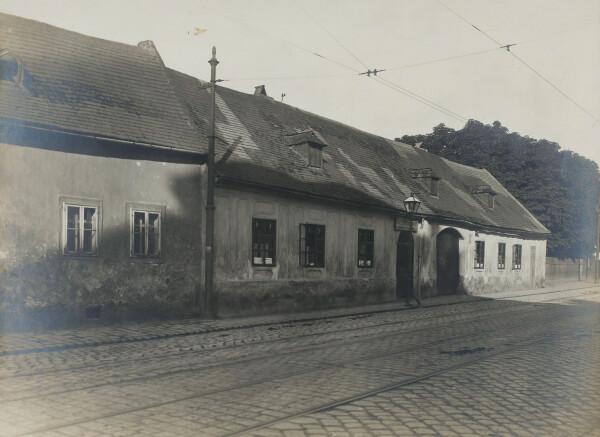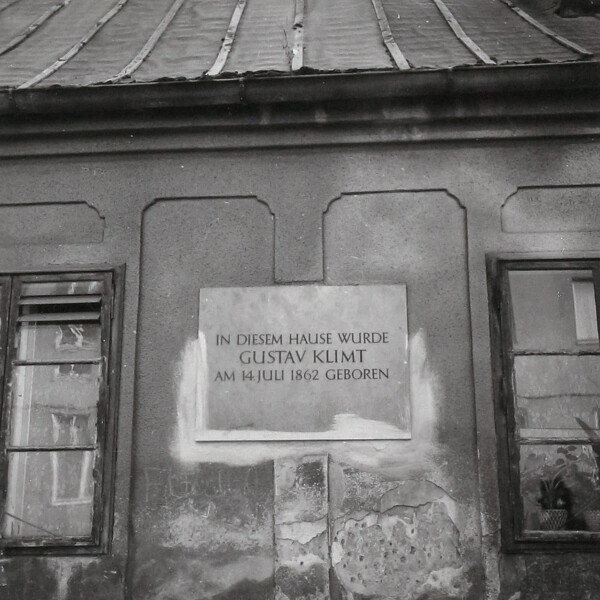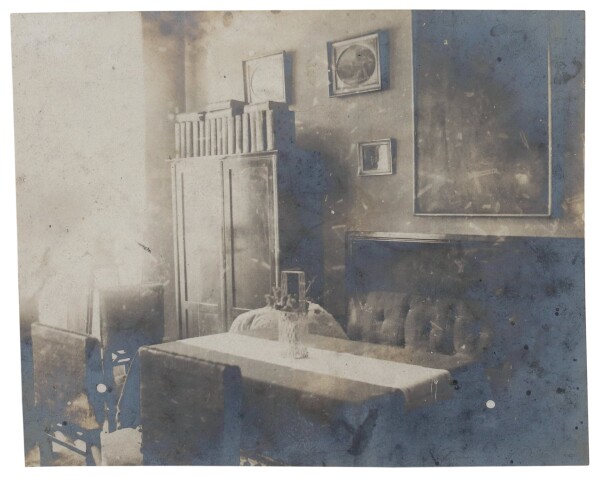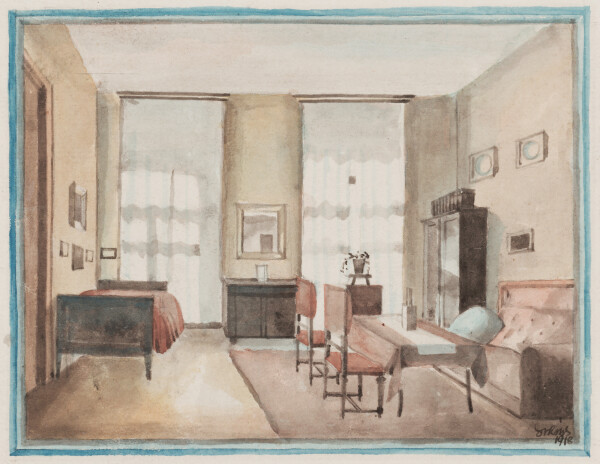Vienna Residences

Gustav Klimt's birthplace in Linzer Straße, presumably 1904-1911, Klimt Foundation
© Klimt Foundation, Vienna

Memorial plaque at Gustav Klimt's birthplace
© Klimt Foundation, Vienna
Gustav Klimt lived at many different addresses with his family in the course of his life. From Baumgarten, then a suburb of Vienna in Lower Austria, the Klimt family soon moved to Vienna. After various changes of adress Klimt settled down at Westbahnstraße 36 in 1897 together with his mother and sisters until his death in 1918.
Gustav Klimt was born as the second child of the family on 14 July 1862 in the former Viennese suburb Baumgarten, at No. 4 (now: Linzer Straße 247). The house was torn down in 1966, but had previously been documented in photographs by Moriz Nähr (a photographer and friend of Klimt’s). These photographs show a single-storey residential building with an adjacent sewing shop, situated next to a tram stop. According to Christian M. Nebehay, the apartment of Klimt’s parents was to the right of the main entrance. The original commemorative plaque that had been affixed to the facade of his birthplace after Klimt’s death is now preserved at the Penzing district museum. Soon after Gustav’s birth, the family moved to Penzing, which, like Baumgarten, still belonged to Lower Austria at the time. There, they lived at an unidentified inn at Linzer Straße 189, where Ernst Klimt was born. The family must have moved again soon after that, because their second daughter Hermine Klimt was born at Baumgarten 12 (now: Linzer Straße 265) in 1865.
Vagabond Life and “Tenement Blocks”
Due to financial difficulties, the Klimts were forced to move frequently. Between 1867 and 1873, they lived at Lerchenfelder Straße 50 in Vienna’s 8th District (“Golden Lion House”), where Gustav Klimt’s brother Georg and his sister Anna were born.
Following a dispute with the landlord, the Klimts moved to Neubaugasse 51 in the 7th District (“Blue Bottle House”), where their youngest daughter Johanna was born. From 1874 at the latest, the family lived at Märzstraße 48 in the 15th District, where the ailing Anna Klimt the Younger died the same year. In 1877, the family moved back to Neubaugasse, settling at No. 8 this time. The following year, the family lived at Mariahilfer Straße 75, 3rd floor, door 37, in the 6th District.
In her handwritten memoirs of her brother’s life, Gustav’s sister Hermine described the various apartments of their childhood as “tenement blocks,” evoking images of small dwellings in houses with narrow staircases, shared sanitary facilities and rooms without daylight. These residential buildings were presumably in bad repair. The “Blue Bottle House”, for instance, was renovated because of its dilapidation and decay only 10 years after the Klimts had moved out. Every time they were unable to pay the rent, the family was evicted and had to move on.
The family’s financial situation improved from 1879, when Ernst and Gustav began to contribute to various commissions of their art teachers. Both sons were now making a living and were thus able to support their parents.
In 1884 the family moved to Stuckgasse 6, 2nd floor, in the 7th District. In the directory Lehmann’s allgemeiner Wohnungsanzeiger, Ernest Klimt the Elder is listed at this address from 1889. In 1890, the family moved to Burggasse 47 in the 7th District. Ernest Klimt the Elder is first listed at this address in Lehmann’s in 1891. A handwritten note from 1893, addressed to Gustav Klimt at Burggasse 47, confirms that the 31-year-old painter was still living with his parents at the time. His brother Ernst the Younger had meanwhile moved into his own apartment in 1891, together with his newlywed wife Helene Flöge.

Gustav Klimt's apartment in Westbahnstraße, presumably after 1898, Klimt Foundation
© Klimt Foundation, Vienna

Julius Zimpel: Gustav Klimt's apartment at Westbahnstraße 36, 1918, ARGE Gustav Klimt Collection, on permanent loan from Leopold Museum, Vienna
© Leopold Museum, Vienna
The Last Residence
After the death of his father, Gustav Klimt moved into an apartment he shared with his unmarried sisters and his mother, for whom he had assumed legal guardianship, as well as his younger brother Georg at Westbahnstraße 36, 2nd floor, in the 7th District in 1897. Gustav Klimt’s mother Anna writes of the move in a letter:
“[…] we will not move out until next week. As the new apartment has to be cleaned thoroughly and our current apartment will not be occupied again until November.”
The location of the new apartment was very convenient for the artist, since it was within walking distance of his studio at Feldmühlgasse 9 (now: No. 11), his favorite restaurant – Meierei Tivoli – as well as the Flöge family’s residence at Westbahnstraße 18.
The interior decoration of the rooms is documented in contemporary photographs. Apart from many paintings by the brothers Ernst and Gustav Klimt, the apartment also contained various fixtures and pieces of furniture created by the Wiener Werkstätte.
The family’s residential registration forms and the listings in Lehmann’s allgemeiner Wohnungsanzeiger reveal that the apartment was initially listed in the name of Anna Klimt. It was only after her death in 1915 that Gustav Klimt was registered as the primary tenant. He continued to live at Westbahnstraße 36 together with his two unmarried sisters until his death in 1918.
Literature and sources
- Mona Horncastle, Alfred Weidinger: Gustav Klimt. Die Biografie, Vienna 2018.
- Sandra Tretter, Peter Weinhäupl (Hg.): Chiffre: Sehnsucht – 25. Gustav Klimts Korrespondenz an Maria Ucicka 1899–1916, Vienna 2014.
- Sandra Tretter, Peter Weinhäupl, Felizitas Schreier, Georg Becker (Hg.): Gustav Klimt. Atelier Feldmühlgasse 1911–1918, Vienna 2014.
- Christian M. Nebehay (Hg.): Gustav Klimt. Dokumentation, Vienna 1969, S. 12-16.
- Adolph Lehmann's allgemeiner Wohnungs-Anzeiger. Nebst Handels- u. Gewerbe-Adressbuch für d. k. k. Reichshaupt- u. Residenzstadt Wien u. Umgebung, 31. Jg. (1889), S. 627, S. 1543.
- Neuigkeits-Welt-Blatt, 28.10.1881, S. 3.
- Gemeinde-Zeitung: unabhängiges politisches Journal, 25.05.1872, S. 4.
- Brief von Anna Klimt in Wien an Gustav Klimt (Anfang Juli 1897). GKA48.
- Korrespondenzkarte von Ferdinand Laufberger in Wien an Gustav Klimt in Wien (24.01.1880). GKA51.
- Adolph Lehmann's allgemeiner Wohnungs-Anzeiger. Nebst Handels- u. Gewerbe-Adressbuch für d. k. k. Reichshaupt- u. Residenzstadt Wien u. Umgebung, 33. Jg. (1891), S. 1619.
- Adolph Lehmann's allgemeiner Wohnungs-Anzeiger. Nebst Handels- u. Gewerbe-Adressbuch für d. k. k. Reichshaupt- u. Residenzstadt Wien u. Umgebung, 11. Jg. (1873), S. 283.
- Adolph Lehmann's allgemeiner Wohnungs-Anzeiger. Nebst Handels- u. Gewerbe-Adressbuch für d. k. k. Reichshaupt- u. Residenzstadt Wien u. Umgebung, 40. Jg., Band 1 (1898), S. 545.

